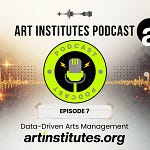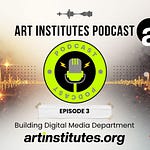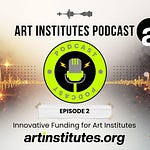Welcome to the Art Institutes Podcast, presented by Art Institutes Organization. This is the show where we celebrate the people and institutions shaping the future of art education and creative industries. Whether you're leading an art institute, teaching the next generation, or managing a cultural space, you're in the right place. So, let's get started!
In Today’s Episode: "Measuring Impact: New Frameworks for Assessing Learning in the Visual & Performing Arts" Sponsored by Art8
As art educators and professionals, we all understand a fundamental truth. The growth of an artist is not always easy to measure. Unlike subjects with clear right or wrong answers, art is more of a journey. It is a process of discovery, of interpretation, and of skill developing over time.
Traditional grades and scores often fail to capture the real story of a student’s progress. So today, let’s talk about how we can better measure the true impact of arts education. We will explore some new ways of thinking about assessment that are more meaningful, more fair, and more inspiring for our students.
Learn More About Smart Souvenirs!
Let’s start by shifting our focus. For a long time, the final artwork or the final performance was everything. But what about the journey to get there? This is where process-based assessment comes in. This approach values the creative process itself.
Think about it. We are looking at the brainstorming and the initial ideas. We are looking at the research a student does, and how they experiment and refine their work along the way. We can see how they collaborate with others and how they participate in critiques. This is where so much of the learning happens. We can measure this growth through tools we already use, like sketchbook checks and reflective journals. We can observe rehearsals and have conversations during work-in-progress critiques. When we focus on the process, we are teaching resilience and adaptability. These are the skills that are absolutely essential for any professional artistic practice.
Now, let’s connect that learning to the real world.
This brings us to what we call authentic assessment. This means creating tasks that mirror what artists actually do in their professional lives.
This could be a portfolio review, a public exhibition, or a performance for a community audience. These are not just tests. They are opportunities for students to build real confidence and show what they are capable of. It gives them evidence of their skills that they can show to colleges or future employers.
But this is only half of the picture. The other half is reflection. High-impact assessment must include student reflection. We need our students to be able to explain their work. We want them to articulate why they made certain artistic choices, or what feedback helped them change their direction.
When a student can explain how their idea evolved, they are developing a powerful skill. It is the skill of thinking about their own thinking. We can encourage this through written artist statements, self-evaluations, and peer-evaluations. This reflection shows a kind of learning that you simply cannot see by looking at the final product alone.
As we update our methods, it is also critical that we make them inclusive. Culturally responsive assessment is about making sure that diverse artistic traditions and identities are respected in our classrooms. This means we must value different cultural styles and aesthetics. It means we avoid forcing a single, narrow standard on our students.
We need to encourage personal voice and personal stories. One of the best ways to do this is to offer students more choice in their projects. Let them choose the medium, the theme, or the cultural references that are meaningful to them. And thankfully, technology can help us with all of this. Digital platforms are changing how we assess. We can use video tools to give feedback on a performance. We can use cloud-based portfolios to track a student’s growth over several years. These tools make evaluation easier and more effective.
So, let’s bring it all together. Building a culture of meaningful evaluation in the arts is not about ranking talent. It is about documenting growth. It is about celebrating creativity and demonstrating how skills are acquired. Most of all, it is about elevating the entire artistic process.
When we use assessment methods that are authentic, that are process-driven, and that are inclusive, we show the true value of what we do. We show how learning in the arts impacts critical thinking, communication, and collaboration. By doing this, we continue to prove why the arts have such an essential place in education and in our society.
Thanks for listening to the Art Institutes Podcast. This episode has been brought to you by Art8, “Webinars for Creatives”. Share your artistic passions, sell your art, learn new skills, and build your tribe, with Live or On-Demand expert webinars. Learn more at www.art8.net. And by arTag, Start making permanent connections with your museum and gallery visitors with Smart Souvenir Coins!
Here's how to stay connected to Art Institutes. First, subscribe to the Art Institutes podcast so you never miss an episode. Next, sign up for our popular newsletter at news.artinstitutes.org.
Together, we're not just supporting the art world, we're redefining it. Thanks for tuning in to the Art Institutes Podcast. Remember, art doesn't just happen. It's foundation is built by institutions and individuals like you. So keep creating, keep leading, and we'll see you next time on the Art Institutes Podcast.














